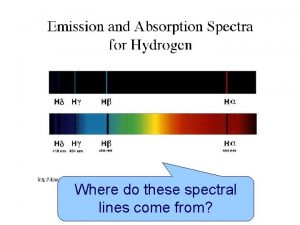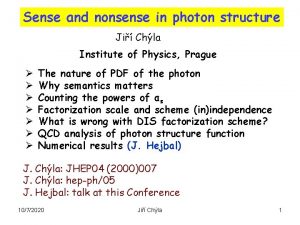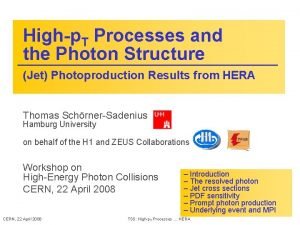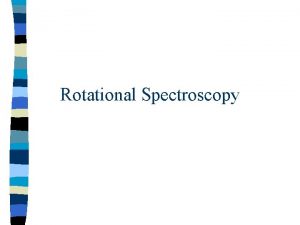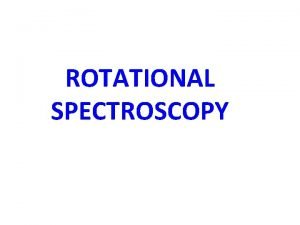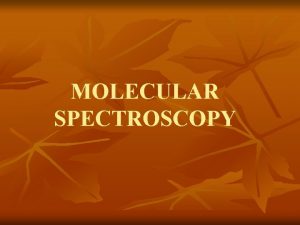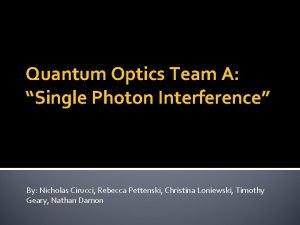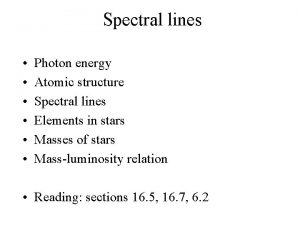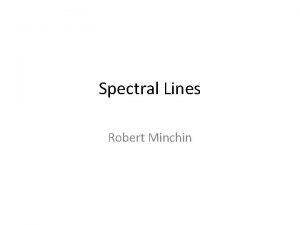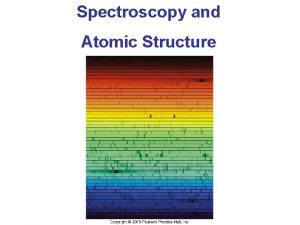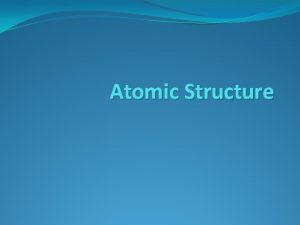Spectral lines Photon energy Atomic structure Spectral lines















- Slides: 15

Spectral lines • • • Photon energy Atomic structure Spectral lines Elements in stars Masses of stars Mass-luminosity relation • Reading: sections 16. 5, 16. 7, 6. 2

Photon energy • Up to now, we have been discussing the wavelength of light as determining it color • However, light comes in discrete packets called photons and the energy of each photon is set by its color or wavelength • From Einstein, we known that the photon energy is inversely proportional to its wavelength

Photon energy

Hydrogen atom Electron orbits around nucleus

Electron orbits From quantum mechanics, only certain orbits are allowed. Each orbit has a specific energy.

How atoms emit light

How atoms emit light • The emitted photon has an energy which is exactly the energy difference between the orbits that the electron had before and after. • Because only certain energies are allowed for the electron orbits, only certain energies of photons can be produced. We call these the spectral lines of hydrogen.

Spectral lines of hydrogen The length of each arrow determines the energy and therefore the wavelength of the photon emitted.

Spectral lines • Each element (hydrogen, helium, neon, mercury, iron, …) has its own particular set of energy levels and its own set of spectral lines. • Do demonstration (7 B 10. 10)

Uses of spectral lines • Because each element has it own unique pattern of spectral lines, the spectral lines from stars can be used to determine the composition, or the relative number of atoms of each elements, of the stars

Kirchoff’s laws • A hot solid, liquid, or dense gas produces a continuous spectrum. • A thin gas in front of a cooler background produces an emission line spectrum. • A thin gas in front of a hot source imprints absorption lines on the spectrum. This is mainly what we see from stars.

Absorption spectrum of a star

Composition of a typical star

Masses of stars • Spectral lines also allow us to measure the velocities of stars via the Doppler shift that we discussed in searching for extra-solar planets. Doppler shift measurements are usually done on spectral lines. • Essentially all of the mass measurements that we have for stars are for stars in binary systems – two stars orbiting each other. • The mass of the stars can be measured from their velocities and the distance between the stars.

Mass-Luminosity relation
 Atomic spectral lines
Atomic spectral lines Photon structure
Photon structure Photon structure
Photon structure Rotational spectral lines
Rotational spectral lines Rotational spectral lines
Rotational spectral lines Rotational spectral lines
Rotational spectral lines Neon spectral lines
Neon spectral lines Relative formula mass of hcl
Relative formula mass of hcl Periodic table.trends
Periodic table.trends Periodic table of elements atomic radius
Periodic table of elements atomic radius Atomic mass of oxygen
Atomic mass of oxygen Difference between atomic mass and atomic number
Difference between atomic mass and atomic number Atomic number vs atomic radius
Atomic number vs atomic radius Motion-to-photon latency
Motion-to-photon latency Frequency unit
Frequency unit Photon
Photon
